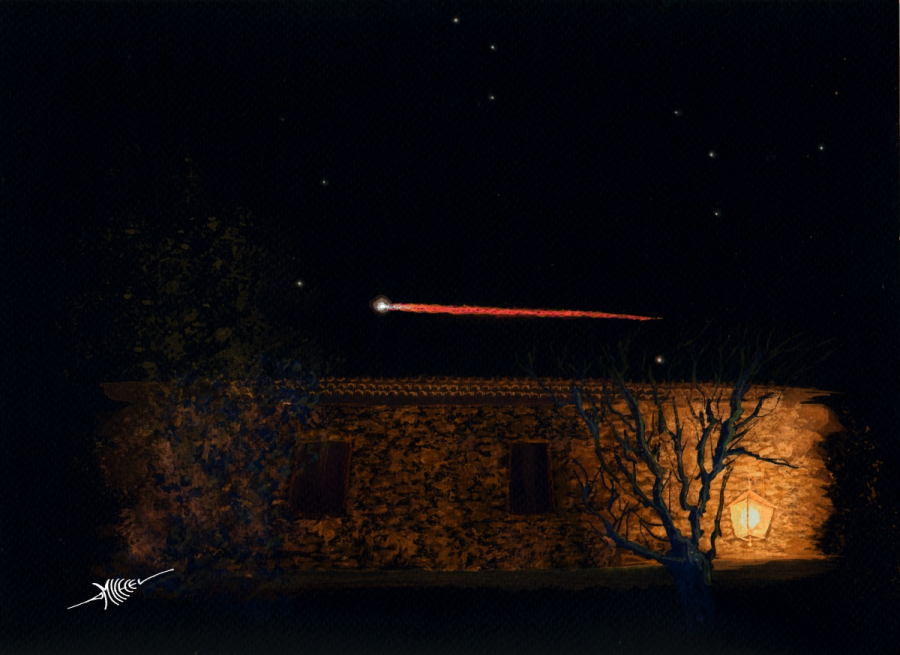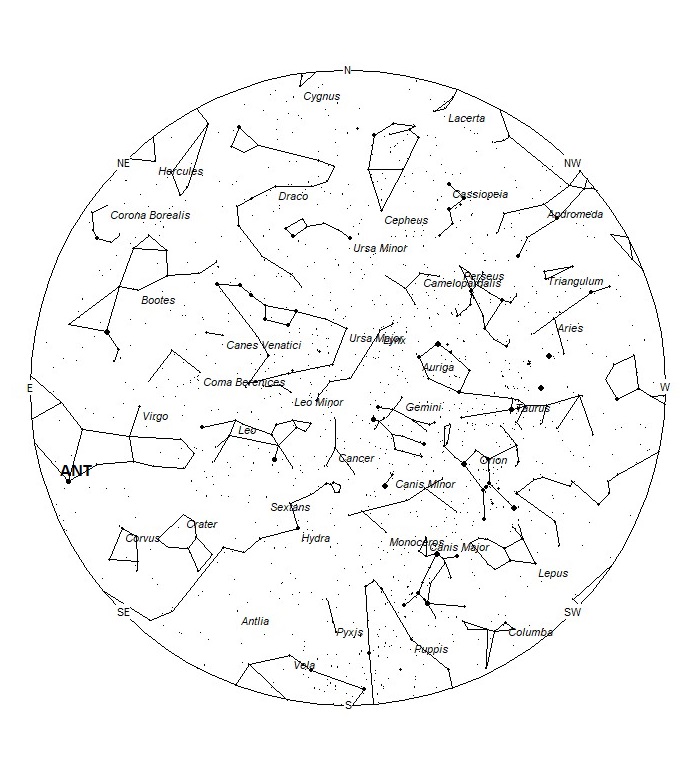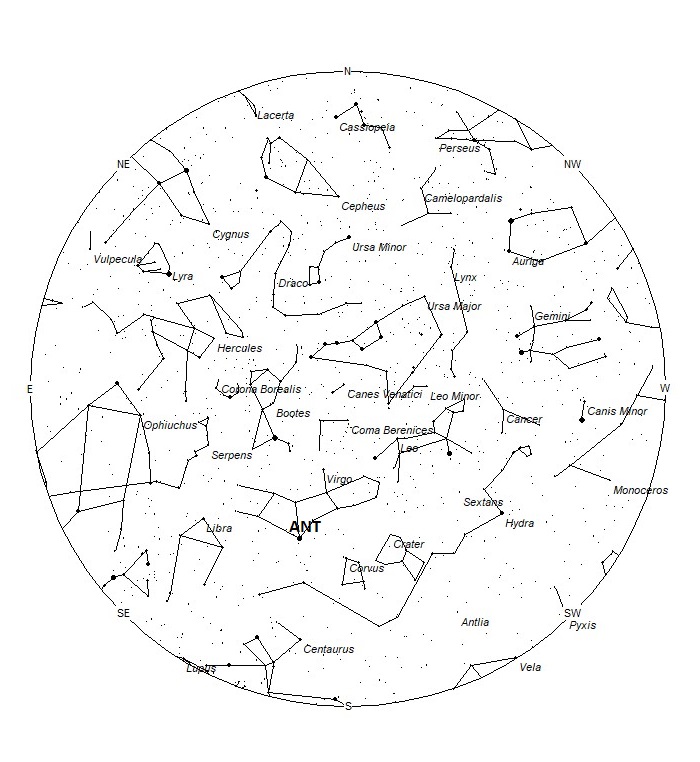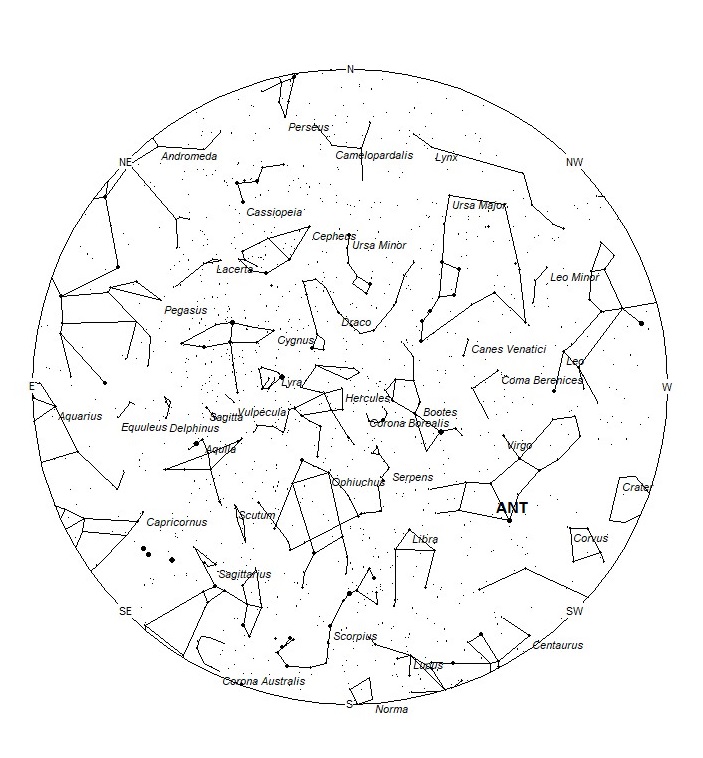
Meteor activity picks up a bit during April as the Lyrids become active during the month. They are active from the 14th through the 30th, with a pronounced maximum on the 22nd. Sporadic rates during April are steady as seen from both hemispheres with southern observers enjoying more activity that can be seen from the mid-northern hemisphere. The eta Aquariids will become active the second half of the month, adding a few swift meteors to the late morning scene.
During this period the moon reaches its first quarter phase on Wednesday April 1st. At this time the moon lies 90 degrees east of the sun and will set near 02:00 local daylight saving time (LDST). This weekend the waxing crescent moon will set during the late evening hours allowing meteor observers to view activity without lunar interference during the more active morning hours. The estimated total hourly meteor rates for evening observers this week is near 3 for those viewing from the southern hemisphere and 2 for those located north of the equator. For morning observers, the estimated total hourly rates should be near 10 as seen from tropical southern locations (25S) and 7 as seen from mid-northern latitudes (45N). The actual rates will also depend on factors such as personal light and motion perception, local weather conditions, alertness and experience in watching meteor activity. Note that the hourly rates listed below are estimates as viewed from dark sky sites away from urban light sources. Observers viewing from urban areas will see less activity as only the brighter meteors will be visible from such locations.
The radiant (the area of the sky where meteors appear to shoot from) positions and rates listed below are exact for Saturday night/Sunday morning March 28/29. These positions do not change greatly day to day so the listed coordinates may be used during this entire period. Most star atlases (available at science stores and planetariums) will provide maps with grid lines of the celestial coordinates so that you may find out exactly where these positions are located in the sky. A planisphere or computer planetarium program is also useful in showing the sky at any time of night on any date of the year. Activity from each radiant is best seen when it is positioned highest in the sky, either due north or south along the meridian, depending on your latitude. It must be remembered that meteor activity is rarely seen at the radiant position. Rather they shoot outwards from the radiant, so it is best to center your field of view so that the radiant lies at the edge and not the center. Viewing there will allow you to easily trace the path of each meteor back to the radiant (if it is a shower member) or in another direction if it is a sporadic. Meteor activity is not seen from radiants that are located below the horizon. The positions below are listed in a west to east manner in order of right ascension (celestial longitude). The positions listed first are located further west therefore are accessible earlier in the night while those listed further down the list rise later in the night.
These sources of meteoric activity are expected to be active this week.
.
The center of the large Anthelion (ANT) radiant is currently located at 13:24 (201) -09. This position lies in central Virgo, 2 degrees northwest of the 1st magnitude star known as Spica (alpha Virginis). Due to the large size of this radiant, Anthelion activity may also appear from Corvus as well as Virgo. This radiant is best placed near 0200 LDST, when it lies on the meridian and is located highest in the sky. Rates at this time should be near 2 per hour no matter your location. With an entry velocity of 30 km/sec., the average Anthelion meteor would be of slow velocity.
As seen from the mid-northern hemisphere (45N) one would expect to see approximately 5 sporadic meteors per hour during the last hour before dawn as seen from rural observing sites. Evening rates would be near 1 per hour. As seen from the tropical southern latitudes (25S), morning rates would be near 8 per hour as seen from rural observing sites and 2 per hour during the evening hours. Locations between these two extremes would see activity between the listed figures.
| SHOWER | DATE OF MAXIMUM ACTIVITY | CELESTIAL POSITION | ENTRY VELOCITY | CULMINATION | HOURLY RATE | CLASS |
| RA (RA in Deg.) DEC | Km/Sec | Local Daylight Saving Time | North-South | |||
| Anthelion (ANT) | – | 13:24 (201) -09 | 30 | 02:00 | 2 – 2 | II |
 American Meteor Society
American Meteor Society



I saw a meteor on March 26, 2019 at 6:20am. I was driving to work on Hwy 97 just past The Punta Norte Bed and Breakfast when I saw a bright yellow object coming down from the sky. Was absolutely amazing!!